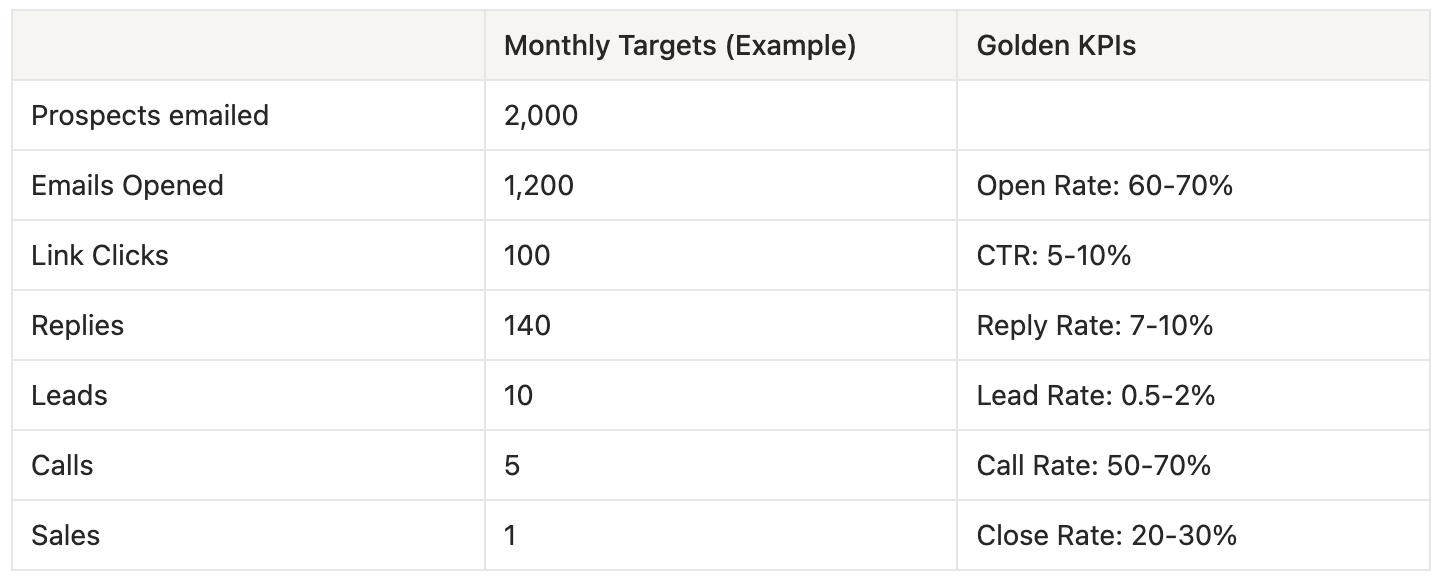Build a Cold Outbound Strategy in 8 Steps
If you want to be successful with cold outbound, you need a solid strategy. But where do you start? It can feel overwhelming at first, but don’t worry. Here’s a simple guide to help you build your cold outbound strategy in 8 steps.
Once you’ve got this in place, you can start executing with confidence.
Step 0 - Assumptions
This outbound strategy assumes you’ve already defined your ICP (at both the account and person level) and built a strong offer.
If you haven’t, focus on those first - then come back to this guide to build your outbound strategy.
Step 1 - Audience Research
Define your TAM and SAM.
TAM / SAM Accounts
Find the number of TAM accounts, i.e. all companies you could potentially serve e.g. 20,000
Find the number of SAM accounts, i.e. all companies you can realistically serve e.g. 5,000
TAM / SAM Prospects
Decide the average number of relevant contacts per account. For large accounts, you want 3–4 people; for small accounts, 1–2 people. This should cover the following roles:
- User(s)
- Decision-maker
- Approver (exec/finance)
TAM Prospects = TAM Accounts × Avg. Prospects per Account e.g. 20,000 × 2.5 = 50,000
SAM Prospects = SAM Accounts × Avg. Prospects per Account e.g. 5,000 × 2.5 = 12,500
TAM / SAM
Define ACV (Annual Contract Value) e.g. $20K
TAM = TAM Accounts × ACV e.g. 20,000 × $20K = $400M
SAM = SAM Accounts × ACV e.g. 5,000 × $20K = $100M
Step 2 - Cold Email Targets
- Define sales targets from cold outreach per month.
- Define golden KPIs (benchmarks).
- Calculate the number of prospects to sequence per month.
- Calculate SAM coverage rate = Monthly Prospects ÷ SAM Prospects.
- If the SAM coverage rate is acceptable → proceed. If not → adjust targets or SAM.

SAM coverage rate = 2,000 ÷ 12,500 = 16% per month. That’s a runway of 6 months. That's acceptable. So 2,000 prospects per month is the target.
Step 3 - Intent Signals
There are 3 types of intent data:
- 1st-party data: Information you collect directly from your own audience, customers, or users.
- 2nd-party data: Another company’s first-party data that you access through a direct partnership.
- 3rd-party data: Aggregated information collected by external providers without a direct relationship to the audience.
And there are 5 different sources of intent data:
- Engagement intent data: When a potential customer engages with content e.g. reading, sharing, following, downloading, liking, or commenting.
- Search intent data: When a potential customer searches for a keyword or phrase on a search engine like Google.
- Hiring intent data: Indicates open job roles within a company. If a company is hiring for certain positions, it signals investment in that area.
- Technographic intent data: Information about a company’s tech stack e.g. when they start or stop using a particular technology.
- Firmographic intent data: Information like company size, location, annual revenue, employee count, funding rounds, or expansion plans.
For cold outbound, focus on 2nd and 3rd-party data (1st-party data is more relevant to inbound-led outbound).
Now, identify relevant signals for your ICP.
Example
If you’re selling B2B sales software, relevant signals could include:
- Engagement: Engaging with sales-related content on a competitor’s social media or website
- Search: Searching for “best prospecting tools”
- Hiring: Hiring for SDRs
- Technographic: Using Attio or Breakcold as CRM, Clay for enrichment, Heyreach for LinkedIn messages
- Firmographic: Expanding to a new location
Step 4 - Tech Stack
Choose your tech stack.
Example
- CRM: Attio, Folk or Breakcold
- LinkedIn Messages: LinkedIn Premium
- Scheduling Tool: Calendly
- Domains & Email Accounts: GoDaddy, Hostinger, Google
- Email Warmup: Instantly
- Email Outreach: Instantly
- Multi-Channel Outreach: Lemlist
- LinkedIn Outreach: Heyreach
- Data Sources: Apollo, LinkedIn SalesNavigator, ZoomInfo, Clay, Google Maps
- Enrichment: Clay
Step 5 - List Building
Build your cold list.
- Build a list of ICP-fit accounts
- Add key contacts (user, decision maker, approver. Usually 1–2 people for smaller companies, 3–4 people for larger companies)
- Layer on intent signals (funding, hiring, tech changes, engagement, etc.)
- Score and tier accounts based on fit + signal strength. Tier 1 being strong fit and strong signal. Tier 2 being medium fit and strong signal or strong fit and medium signal. Tier 3 being weaker fit or signal.
- Prioritize outreach: Tier 1 → Tier 2 → Tier 3
- Expand and update monthly
Step 6 - Email Infrastructure & Deliverability
Setup domains, configure technical records, setup and warmup inboxes.
Setting Up Your Inbox
- Determine number of domains and accounts.
- Buy domains and accounts.
- Redirect new domains + forward to primary inbox.
- Configure SPF, DKIM, DMARC.
- Pick cold email tool.
- Create consistent profiles.
- Send plain text emails.
- Include an unsubscribe link.
- Respect sending limits (~30/day/account).
- Warmup inboxes.
How Many Domains & Accounts?
- 1 account = 30 emails/day × 20 days/month = 600 emails/month.
- Let’s assume we send no more than 3 emails to each prospect per month.
- Targeting 2,000 prospects × 3 emails each (max) = 6,000 monthly emails → 10 accounts needed.
- Use a maximum of 2–4 accounts per domain.
- So, for example, you might use 3–5 domains with 2–4 accounts each (e.g. 5 domains × 2 accounts = 10 total).
Warming Up Inboxes
- Warmup for 3–4 weeks before running campaigns.
- Start at 5/day, ramp-up to 30/day.
Step 7 - Outreach
Now you will want to define your outreach messaging and channels.
Messaging Example
Personalize your outreach.
- If there's an intent signal, personalize based on signal + ICP (account + person) + offer + awareness level / funnel stage
- Otherwise, personalize based on ICP (account + person) + offer + awareness level / funnel stage
Channels Example
- Email (using monthly targets above)
- Supplement with LinkedIn connection requests, DMs, likes and comments
- Can also include phone and ads to boost further
Step 8 - More Outreach
As you start to build confidence with cold outreach, you can start to look at re-engagement and re-activation.
List Building
- Re-Engagement: Build a list of dormant leads who have a high chance of being re-engaged.
- Re-Activation: Build a list of past customers who have a high chance of being re-activated.
Outreach
- Re-Engagement: Outreach to dormant leads in CRM.
- Re-Activation: Outreach to past clients/customers in CRM.
Takeaways
- Define your ICP and build a strong offer.
- Define your audience (TAM and SAM).
- Set clear cold email targets.
- Identify relevant 2nd and 3rd-party intent signals.
- Choose your tech stack.
- Build your cold list (layer in intent signals and score leads).
- Set up email infrastructure and warm up accounts.
- Finalize your messaging and channel strategy.
- Expand outreach to re-engagement (past leads) and re-activation (past customers).
